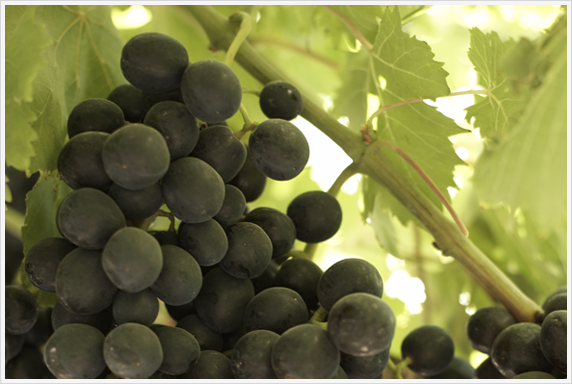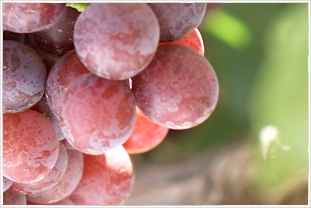

A Resource for California Central Valley Table Grapes, a commodity-based identification resource, was created to provide growers, the industry, and those associated with table grape trade activities an easily accessible site to link to digital tools developed by, or to be developed by, USDA's Center for Plant Health Science and Technology (CPHST) and others. This type of resource gives end-users a diversity of multimedia, such as keys, images, and fact sheets, to support the screening and potentially the identification and diagnosis of often diverse groups of pests and diseases associated with a specific trade product—in this case, table grapes.
When originally conceived, CPHST decided that the resource would include various internet-based identification tools for pest, disease, disorder, and host screening. A digital identification tool is defined here as a stand-alone website containing one or more interactive keys along with a home page and other supplementary pages not directly attached to the matrix key (e.g., glossary, references). The table grape resource, when completed, will include two types of identification tools: 1) a symptom-based tool to support field screening and identification of diseases and physiological disorders based on the visible symptoms they cause on their hosts (the grapes); and 2) taxon-based tools to support screening and identification within a particular group of organisms (weed seeds, spiders, the grape varieties themselves, etc.).
For the identification keys contained within the resource, CPHST chose a matrix-based, interactive, electronic format. Matrix keys, unlike traditional pathway (i.e., dichotomous) keys, are media-rich and allow users considerable flexibility in the choice of characters. Lucid3 software, developed by the Centre for Biological Information Technology (University of Queensland), was selected since it is the most widely used matrix key-building software, both nationally and internationally. Written in Java, Lucid3 is a cross-platform implementation that will run on any Java-enabled operating system without the need for additional software. A wealth of media, such as fact sheets, drawings, photographs, and videos, can be attached to the characters and taxa in Lucid keys, enhancing the identification process. Moreover, a Lucid key can be presented as an integral component of a comprehensive website, such as a site about a particular genus or a specific commodity.
A Resource for California Central Valley Table Grapes will ultimately provide links to five separate identification tools (see below). Each tool will also be linked back to the resource to allow convenient access. Each tool can, however, stand on its own for those users with more specific needs.
The resource and its associated tools were designed and developed to support the use by the following suite of clients. Additional end-users of the tools not listed below will likely also benefit from the resource.
• USDA APHIS Plant Protection & Quarantine (PPQ), particularly officials involved in the pre-clearance of California table grapes bound for
export
• California Central Valley table grape growers
• California Central Valley County Agricultural Inspectors
• California Department of Food & Agriculture (CDFA)
 The table grape resource provides screening and identification support for varieties of grapes and their pests, diseases, and disorders known to occur in the table grape production areas of the southern San Joaquin Valley in California's Central Valley. This area is the major region in California where table grapes are grown for export to other countries. Special emphasis has been placed on the biosecurity concerns of two of our trading partners—Australia and New Zealand. If you suspect that you have detected a species of concern (i.e, one that could delay the export of table grapes to these or other countries), you should submit the sample for verification to appropriate individuals within the county or state.
The table grape resource provides screening and identification support for varieties of grapes and their pests, diseases, and disorders known to occur in the table grape production areas of the southern San Joaquin Valley in California's Central Valley. This area is the major region in California where table grapes are grown for export to other countries. Special emphasis has been placed on the biosecurity concerns of two of our trading partners—Australia and New Zealand. If you suspect that you have detected a species of concern (i.e, one that could delay the export of table grapes to these or other countries), you should submit the sample for verification to appropriate individuals within the county or state.

Identification Tool to Weed Disseminules of California Central Valley Table Grape Production Areas (TGWD) TGWD is designed to aid in the screening and detection of weed disseminules that could find their way into table grape bunches grown in the southern San Joaquin Valley (Madera, Kern, Kings, Fresno, and Tulare Counties). Particular emphasis is placed on the risk assessment of these weed taxa by two of our trading partners, Australia and New Zealand. Identification keys include a General Key (mostly non-grasses) and a Grass Key.
Table Grape Spider ID (TGSId) TGSId is designed to aid in the screening and detection of spiders and spider egg sacs found in the California Central Valley where table grapes are grown. Its utility is geared to the commodity inspectors at both the exporter (California) and importer (Australia, New Zealand) ends, with the goal of clearing shipments more quickly. In addition to the morphologically-based keys for identifying adult spiders and spider egg sacs, this tool includes an image gallery and a DNA sequence database for the spider taxa.
Table Grape ID: Varieties of California's Central Valley Over 50 varieties of grapes have been grown for their fresh fruit (i.e., table grapes) in California. Unfortunately, the histories and descriptions of these varieties are sometimes unclear or incomplete. Since varieties can differ with respect to various physiological processes and responses, including disease and disorder susceptibilities, this tool will attempt to pull together all pertinent information for varieties grown in California's Central Valley in the effort to improve identification in the field.
Arthropod Pests of California Central Valley Table Grapes Table grapes are susceptible to damage from a variety of arthropod pests. Those that have occurred or could occur on the crop as it is grown in California's Central Valley will be included in this screening and identification tool.
Symptoms of Diseases and Disorders of California Central Valley Table Grapes The resource's symptomatic tool will provide identification support for currently known diseases and disorders of table grapes in California's Central Valley. A table grape disease is the result of a dynamic, detrimental relationship with a transmissible organism that interferes with the normal processes of the plant's cells or tissue. The organism that incites or causes the disease process with the host is called a pathogen, and may be a bacterium [including Mollicutes (phytoplasmas and spiroplasmas)], protozoan, fungus, nematode, or virus. Table grape disorders, including environmental sensitivity, nutritional deficiency, stress, and physical injury, are considered disorders rather than diseases because they are caused by environmental conditions rather than by transmissible pathogens.
 Various organizations and individuals provided help with the initiation, development, and deployment of A Resource for California Central Valley Table Grapes. USDA APHIS PPQ CPHST Identification Technology Program (ITP) Team, the coordinators of the resource, would like to thank the Foreign Agricultural Service (FAS) for financial support, Sean McCue of Sean McCue Design for web design support, California Table Grape Commission for images, John Loyd and Barbara Maehler (PPQ) for logistical support in California, and Deena Walters for production support.
Various organizations and individuals provided help with the initiation, development, and deployment of A Resource for California Central Valley Table Grapes. USDA APHIS PPQ CPHST Identification Technology Program (ITP) Team, the coordinators of the resource, would like to thank the Foreign Agricultural Service (FAS) for financial support, Sean McCue of Sean McCue Design for web design support, California Table Grape Commission for images, John Loyd and Barbara Maehler (PPQ) for logistical support in California, and Deena Walters for production support.
Numerous agencies, institutions, organizations, and individuals provided their expertise and support to the development of the separate tools of this resource. This support included specimens for evaluation as well as reviews of the scientific information contained in fact sheets and keys. Please refer to each tool's acknowledgement page to learn about these generous groups and individuals.

Walters, T.W. 2011. A Resource for California Central Valley Table Grapes. Identification Technology Program, CPHST, PPQ, APHIS, USDA; Fort Collins, Colorado. http://itp.lucidcentral.org/id/table-grape/resource
[date accessed]
A Resource for California Central Valley Table Grapes was published by the USDA APHIS PPQ Center for Plant Health Science and Technology (CPHST). CPHST is the scientific support organization for the Plant Protection and Quarantine (PPQ) division of the Animal and Plant Health Inspection Service (APHIS) of the United States Department of Agriculture (USDA).
While the developers have made every effort to provide accurate information in A Resource for California Central Valley Table Grapes, they and their affiliated organizations specifically disclaim all legal liability with respect to the accuracy, completeness, or usefulness of any information contained in the resource and its associated tools. The coordinators, developers, and associated agencies, institutions, and organizations shall assume no legal liability for any damages, including direct, indirect, consequential, compensatory, special punitive, or incidental damages, arising from or relating to the use of A Resource for California Central Valley Table Grapes and its associated tools or the information and material provided by or linked from A Resource for California Central Valley Table Grapes and its tools.
Some web pages in the resource and associated tools provide links to Internet sites for the convenience of the resource's clients. The resource coordinators and tool developers, and their associated agencies, institutions, and organizations are not responsible for the availability or content of these external sites, nor do these individuals, agencies, institutions, and organizations endorse or warrant the products, services, or information described or offered by these Internet sites.
This page must be taken into consideration with other similar pages contained within each resource tool concerning copyright and disclaimers when copying or distributing information from a specific tool.